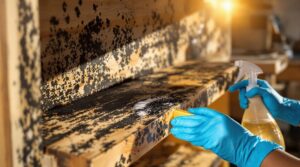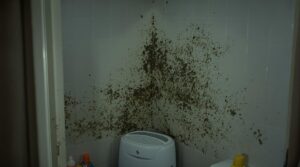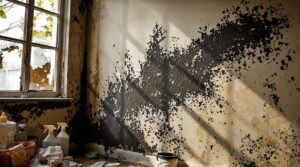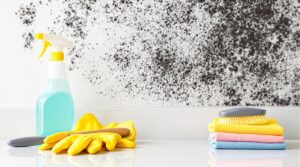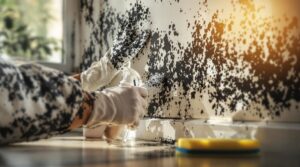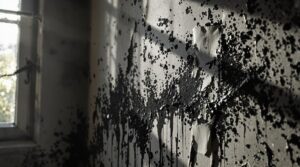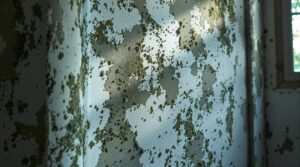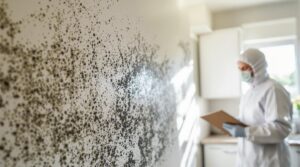Removing mold from under wood floors requires proper safety equipment including an N95 respirator, goggles, and protective clothing. The affected area must be contained using plastic sheeting and tape before treatment begins. Cleaning solutions such as white vinegar, hydrogen peroxide, or EPA-registered products can be applied after proper ventilation is established. For areas larger than 10 square feet, professional remediation is recommended. Understanding the complete removal process guarantees safe and effective long-term results.
Key Takeaways
- Wear proper safety equipment including N95 respirator, goggles, coveralls, and gloves before beginning mold removal work.
- Create containment barriers using plastic sheeting and tape to prevent mold spores from spreading to other areas.
- Inspect subfloor thoroughly and use HEPA vacuum equipment to remove loose mold debris before applying cleaning solutions.
- Apply EPA-registered cleaning solutions like RMR-141 or diluted bleach solution while maintaining proper ventilation.
- Contact professional remediation services for areas larger than 10 square feet or if structural damage is present.
Signs of Mold Growth Under Wood Floors
Mold infestation beneath wood flooring presents several recognizable warning signs that homeowners must monitor. Visual indicators include floor discoloration caused by mold enzymes degrading the wood material, along with distinct clusters of green, blue, or black spores.
Structural weakness manifests through warping, buckling, or the development of soft, spongy areas in the flooring. Mold can develop in as little as 24 to 48 hours after water exposure. People may notice cognitive dysfunction including brain fog and memory problems when exposed to mycotoxins from hidden mold.
A persistent musty odor often accompanies hidden mold growth, while occupants may experience heightened allergic reactions, including respiratory issues and skin irritation. These symptoms can intensify due to the presence of mycotoxins released by active mold colonies.
Physical changes in flooring texture, such as finish deterioration or surface flaking, further indicate potential contamination.
The presence of water damage, evidenced by staining on floors or adjacent walls, suggests conditions conducive to mold proliferation. Professional inspection of these symptoms can confirm the extent of infestation and guide appropriate remediation measures.
Essential Safety Equipment and Preparation
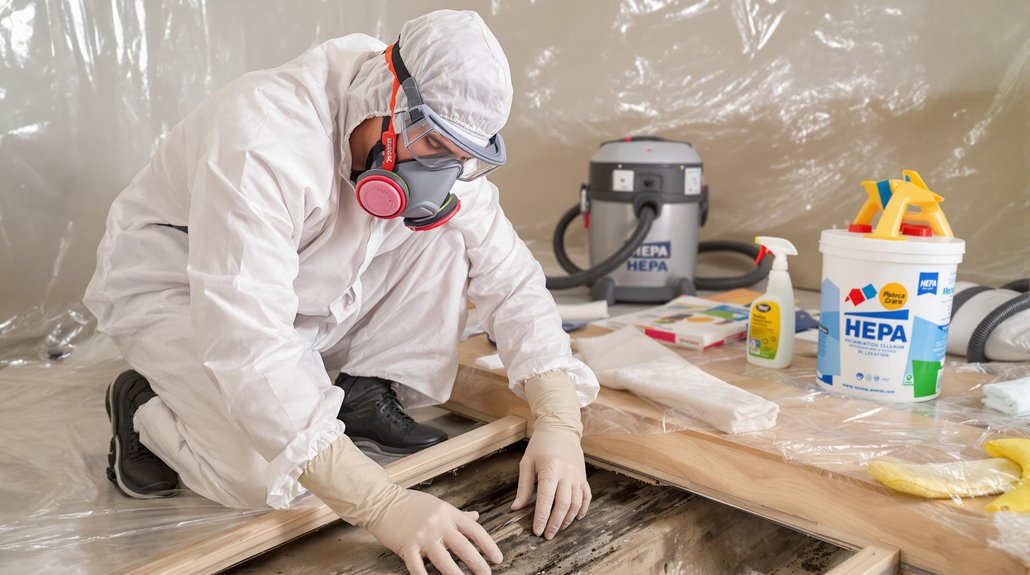
Safe mold remediation requires complete protective measures and proper equipment before beginning any removal work. Essential protective coverage includes a high-quality respirator with N, R, or P-95/P-100 filters, non-vented goggles, and full-body disposable coveralls. A face protection shield provides an additional safeguard against airborne debris and spores. Waterproof boots and long rubber gloves complete the necessary personal protective equipment (PPE) ensemble.
Following proper safety protocols, the work area must be thoroughly sealed with plastic sheeting and tape to prevent cross-contamination. All vents and heat registers require coverage to stop spore migration. The space should be properly ventilated while maintaining containment. Professional containment protocols are mandatory when affected areas exceed 10 square feet.
Before remediation begins, gather specialized cleaning solutions, HEPA vacuum equipment, and mold inhibitors. Test cleaning solutions on a small area to verify surface compatibility. These precautions are critical, as exposure to mold spores can cause serious respiratory infections, allergic reactions, and irritation to eyes, nose, and throat.
Step-by-Step Mold Removal Process
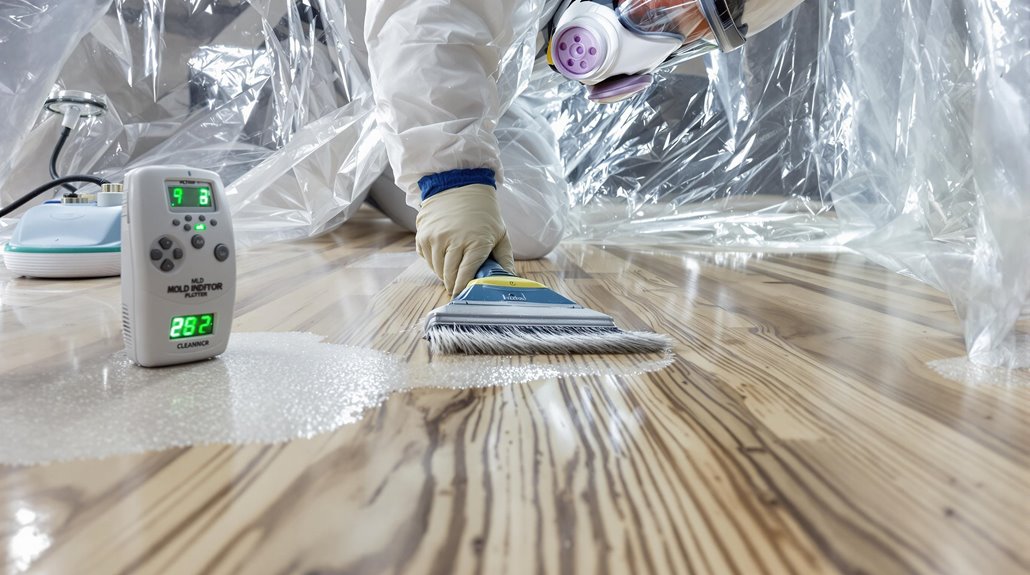
Implementing a systematic mold removal process requires careful attention to preparation and environmental controls before any remediation work begins. The process involves sequential steps that guarantee thorough removal while maintaining safety protocols and preventing cross-contamination. Poor ventilation during cleanup can severely hamper mold removal effectiveness and create unsafe working conditions. EPA-approved biocides must be carefully applied using proper respiratory protection to ensure effective treatment.
| Phase | Action | Safety Control |
|---|---|---|
| Preparation | Clear and cover area | PPE equipment check |
| Assessment | Inspect subfloor damage | Air quality monitoring |
| Removal | Apply cleaning solution | Ventilation methods |
| Treatment | Implement scraping techniques | Containment verification |
| Prevention | Apply mold inhibitor | Environmental control |
After securing the workspace, technicians must employ proper ventilation methods to maintain air quality throughout the remediation process. The application of appropriate cleaning solutions, followed by systematic scraping techniques, ensures complete mold removal from the subfloor surface. Once the affected area is thoroughly cleaned and dried, professionals apply specialized mold inhibitors to prevent future growth. This methodical approach, combined with proper moisture control measures, creates an environment unsuitable for future mold colonization.
Best Cleaning Solutions and Products
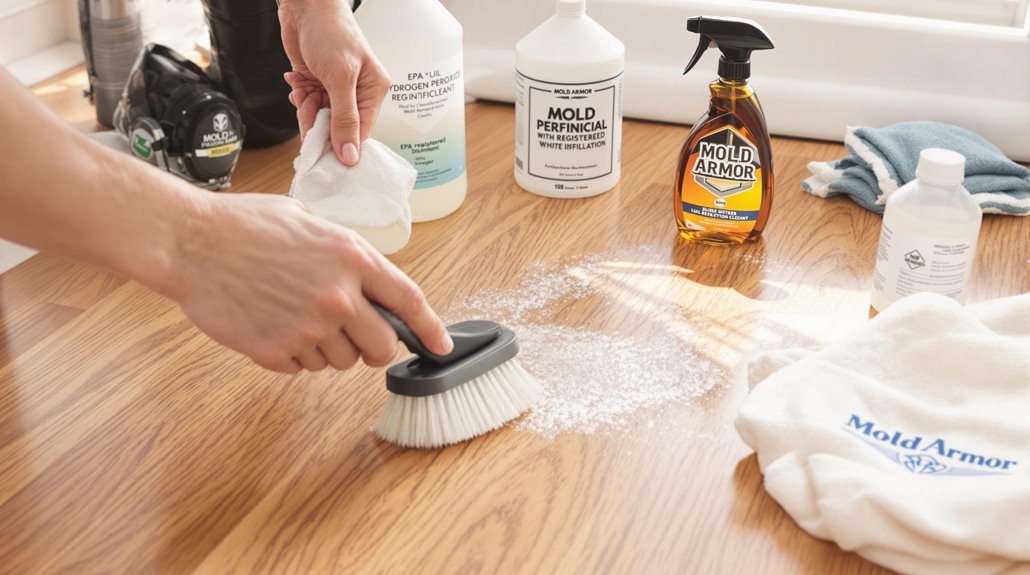
Selecting appropriate cleaning solutions and products represents a key component in successful mold remediation of wood floors. When making cleaning comparisons, both natural and commercial options demonstrate varying solution strengths in combating mold growth.
White vinegar mixed with water offers an effective natural remedy, while hydrogen peroxide serves as another non-toxic alternative.
For commercial products, EPA-registered solutions like RMR-141 Disinfectant provide fast-acting results against mold and mildew.
Diluted bleach solutions, mixed at a ratio of 1:10 with water, effectively eliminate mold growth. However, all cleaning agents should undergo preliminary testing on inconspicuous areas to prevent wood damage. To ensure the best results when using diluted bleach solutions, it is crucial to follow proper safety precautions, such as wearing gloves and ensuring good ventilation in the area being treated. In addition to bleach, there are several other methods available for how to remove mold from wood, including vinegar or specialized mold removers. After treatment, regularly monitoring the area for any signs of mold recurrence can help maintain the integrity of the wood and prevent further growth.
Mild detergents and specialized wood floor cleaners present balanced options that protect wood integrity while addressing mold issues.
Products like Mold Armor Mold Blocker offer extended protection against future growth. When selecting cleaning solutions, prioritize non-abrasive formulations that won't compromise the wood's finish or structural integrity.
Using quaternary ammonium compounds provides rapid elimination of mold through cellular membrane disruption.
Professional Treatment Vs DIY Methods
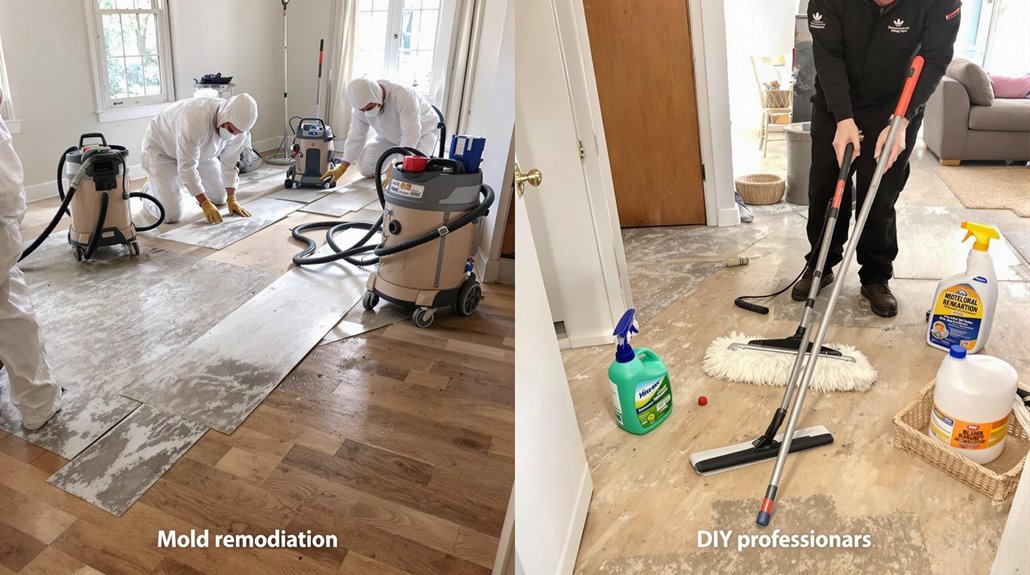
When addressing mold remediation on wood floors, homeowners must carefully weigh the decision between professional treatment and DIY methods based on several critical factors. While DIY removal methods may suffice for small surface areas under 10 square feet, professional intervention becomes necessary for extensive infestations or cases involving structural concerns.
Professional treatment options offer complete solutions, utilizing specialized equipment and advanced techniques that guarantee thorough removal and prevention of cross-contamination. Professionals can effectively identify moisture sources, implement proper containment measures, and provide documentation for insurance purposes.
In contrast, DIY removal methods, though cost-effective for minor cases, carry inherent risks including inadequate removal and potential health hazards due to improper handling. The choice between these approaches ultimately depends on the extent of infestation, location of mold, and whether the contamination has penetrated beneath the wood flooring or into surrounding materials. Professional remediation experts maintain indoor humidity levels between 30-50% to prevent future mold growth after treatment.
Long-Term Prevention Strategies

Maintaining proper moisture control through ideal humidity levels and adequate ventilation serves as the foundation for preventing mold growth on wood floors.
Regular inspections of both the flooring surface and subfloor structure enable early detection of potential moisture issues before they escalate into serious mold problems.
The implementation of moisture barriers, quality sealants, and routine maintenance checks creates a complete defense system against conditions that promote mold development.
Keeping indoor humidity between 30-60% is critical for preventing the damp conditions that allow mold to develop within 24-48 hours.
Proper Moisture Control Methods
Effective moisture control serves as the cornerstone of preventing mold growth in wood floors. A thorough approach includes installing vapor barrier membranes in crawlspaces and implementing proper ventilation systems. Regular moisture mapping of the subfloor helps identify potential problem areas before they develop into serious issues.
Humidity control through dehumidification equipment maintains ideal moisture levels in the space, while specialized moisture-reducing membranes and moisture-control adhesives provide additional protection.
For maximum effectiveness, the installation of proper insulation in crawlspaces and sealing of all gaps in the flooring system prevents condensation formation.
Professional-grade moisture testing should be conducted regularly to monitor conditions, and environmental controls should be adjusted accordingly to maintain appropriate indoor humidity levels that protect wood flooring from excess moisture exposure.
Keeping indoor relative humidity below 65% is critical for preventing mold development in wooden subfloors and structural components.
Regular Floor Inspections
Regular floor inspections form the foundation of a thorough mold prevention strategy. Property owners should establish consistent inspection intervals, focusing particularly on areas prone to moisture exposure, such as basements, bathrooms, and spaces near plumbing fixtures.
The recommended inspection frequency includes annual exhaustive evaluations supplemented by targeted quarterly checks of high-risk zones.
During these assessments, inspectors should conduct visual examinations for water stains, discoloration, or musty odors. Professional moisture testing tools can detect hidden dampness beneath floorboards. Crawlspaces require special attention, as they often harbor concealed moisture problems that can affect floor integrity.
Maintaining detailed inspection records helps track patterns of moisture accumulation and validates compliance with property maintenance regulations while enabling early intervention in potential mold situations.
Since mold thrives in environments with 70-90% water content, ensuring proper ventilation and moisture control is essential during inspections.
The Benefits Of Consulting A Public Adjuster
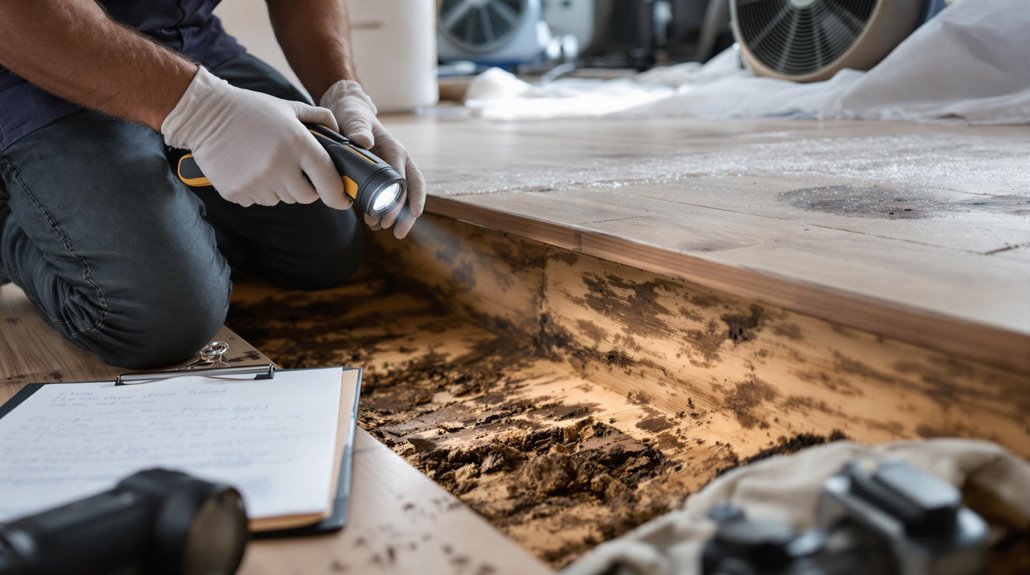
When dealing with extensive mold damage on wood floors, consulting a public adjuster provides critical expertise in steering complex insurance claims and securing maximum settlements.
These licensed professionals conduct thorough, objective assessments of mold damage while managing all aspects of the claims process, from documentation to negotiation with insurance companies.
Their specialized knowledge typically results in higher claim payouts and guarantees homeowners receive fair compensation for both immediate remediation needs and long-term restoration of affected wood flooring.
Studies indicate that insurance claims handled by public adjuster representation can result in settlements up to 500% higher than those without professional assistance.
Expertise In Insurance Claims
Insurance claims for mold damage in wood floors can present complex challenges that require professional expertise to navigate successfully. Public adjusters possess thorough knowledge of insurance terminology and policy interpretation, enabling them to effectively advocate for policyholders throughout the claims process.
| Expertise Area | Key Capabilities | Policyholder Benefits |
|---|---|---|
| Policy Analysis | Coverage interpretation | Maximum claim value |
| Documentation | Evidence gathering | Complete claim support |
| Negotiations | Strategic advocacy | Higher settlements |
| Claims Process | Procedural knowledge | Efficient resolution |
Their specialized knowledge allows them to identify all applicable coverage options while countering standard insurance company tactics that might minimize settlements. This expertise proves particularly valuable when addressing complex mold damage claims, where proper documentation and understanding of policy exclusions can substantially impact the final settlement amount. Working with a public adjuster typically results in higher settlement amounts compared to handling claims independently.
Objective Damage Assessment
Professional damage assessment conducted by public adjusters provides property owners with a thorough, unbiased evaluation of mold-related issues affecting wood floors.
Through complete damage scoping, adjusters utilize specialized tools to detect hidden growth beneath flooring materials and within subflooring layers.
These experts employ systematic moisture measurement techniques and advanced inspection protocols to identify the full scope of contamination.
Their detailed documentation includes photographic evidence, moisture readings, and complete reports that outline affected areas, structural concerns, and necessary remediation steps. This objective assessment prevents underestimation of damages and guarantees accurate insurance claims.
Streamlined Claim Process
Through the engagement of public adjusters, property owners can substantially streamline their mold-related insurance claims process while maximizing potential settlements. These licensed professionals leverage their expertise in policy interpretation and damage assessment to advocate effectively on behalf of policyholders.
The implementation of digital processing and automated validation systems considerably reduces administrative burdens while minimizing errors in claims documentation.
Public adjusters work systematically with mold remediation experts to guarantee thorough damage assessment, including hidden areas that might otherwise go undetected. Their professional oversight of the claims process includes detailed documentation, accurate cost estimation, and skilled negotiation with insurance companies.
This streamlined approach not only expedites claim resolution but also typically results in higher settlement amounts and improved transparency throughout the entire process.
Higher Claim Payouts & Settlements
Engaging a public adjuster for mold-related claims consistently leads to higher settlements and more thorough coverage of damages. Public adjusters' expertise in property damage assessment and deep understanding of insurance policies enables them to identify hidden damages that might otherwise go unnoticed, substantially impacting settlement trends.
Analysis of payout patterns demonstrates that public adjusters secure higher compensation through their skilled negotiation tactics and exhaustive documentation of damages.
Their thorough understanding of policy coverage and exclusions, particularly regarding mold damage, allows them to build stronger cases for maximum settlements. Working on a contingency basis, these professionals leverage their knowledge to counter insurance company tactics that might minimize payouts. Their persistent advocacy and expertise in policy interpretation guarantee policyholders receive fair compensation for all documented damages.
About The Public Claims Adjusters Network (PCAN)
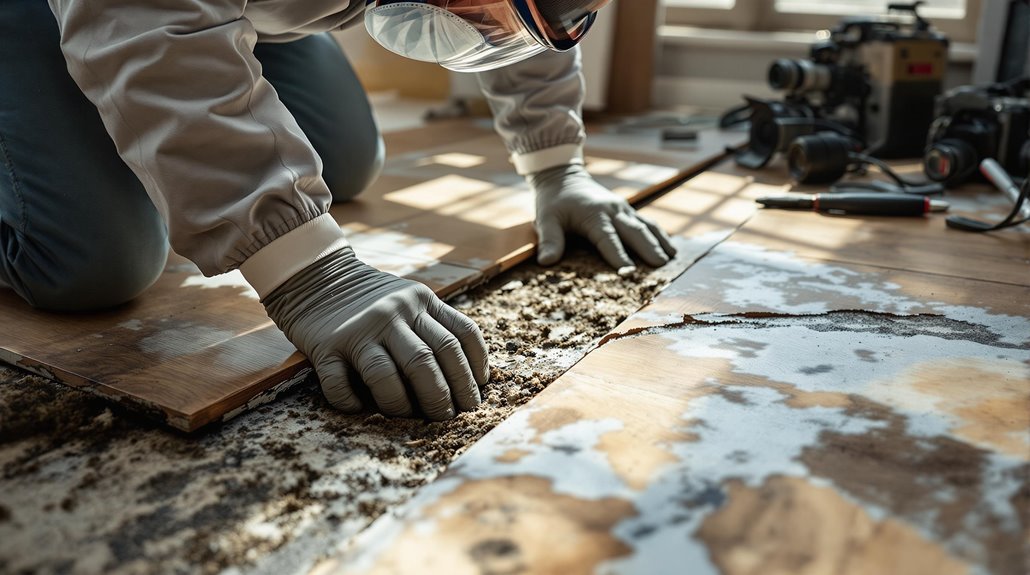
While homeowners often struggle with insurance claims related to property damage, the Public Claims Adjusters Network (PCAN) serves as an essential resource for policyholders seeking expert assistance. These adjuster networks provide complete support throughout the claims process, offering professional advocacy and specialized expertise in claims management.
PCAN members investigate claims, interpret policy coverage, and negotiate settlements with insurance companies to maximize policyholder benefits.
Operating within an established network of experienced professionals, public adjusters charge a percentage of the final settlement for their services. They provide detailed documentation, maintain efficient communication, and implement customized solutions for each claim.
These networks particularly excel in handling catastrophic events and complex claims, ensuring policyholders receive thorough representation. Through their systematic approach to claims management, PCAN members guide clients through the entire process, from initial documentation to final settlement, while maintaining professional standards and ethical practices.
Frequently Asked Questions
How Long Should I Wait Before Replacing Flooring After Mold Removal?
After mold removal, wait 2-3 days minimum while monitoring drying periods. Professional moisture testing should confirm humidity levels below 15% before proceeding with new flooring installation.
Can I Paint Over Moldy Wood Instead of Removing It?
Surface sealing or mold encapsulation through painting is not recommended, as it fails to address active mold growth. The mold continues spreading beneath, compromising structural integrity and posing significant health risks.
Will Homeowner's Insurance Cover Mold Damage Under Wooden Floors?
Like traversing a complex maze, homeowner's insurance coverage for under-floor mold depends on the cause. Coverage applies for sudden water events, but policy exclusions and insurance deductibles affect claim eligibility.
Does UV Light Treatment Effectively Kill Mold Under Wood Floors?
UV light treatment's effectiveness is limited by poor light penetration through wood flooring. Despite UVC wavelength effectiveness against mold, direct exposure cannot be achieved beneath solid floor materials.
Can Pets Get Sick From Mold Growing Under Wooden Floors?
Ever wonder how hidden mold affects your pets? Mold growing under wooden floors can cause severe pet symptoms through spore inhalation, including respiratory distress, gastrointestinal issues, and behavioral changes from continuous mold exposure.
References
- https://jrkflooring.com/blog/mold-on-the-hardwood/
- https://www.flooringhq.com/wood-flooring/how-to-remove-mold-from-flooring/
- https://buildingservicesinc.com/how-to-remove-mold-under-hardwood-floors/
- https://www.stimsonlumber.com/wp-content/uploads/2018/08/Cleaning_Mold_on_Wood.pdf
- https://orange-restoration.com/hardwood-floor-mold-damage/
- https://www.bobvila.com/articles/signs-of-mold-under-hardwood-floors/
- https://moldinspect.org/7-signs-of-mold-under-hardwood-floors-in-your-commercial-property/
- https://cfmoldinspect.com/mold-under-flooring
- https://www.clearpropertyinspections.com/mold-air-quality/dangers-of-mold-growth-under-flooring/
- https://www.instructables.com/How-to-Clean-Mold-from-a-Wood-Floor/
